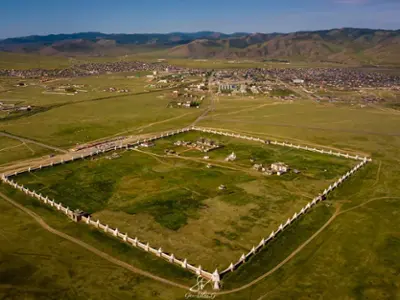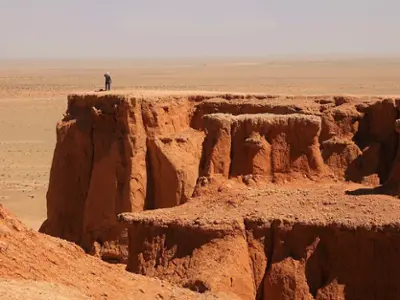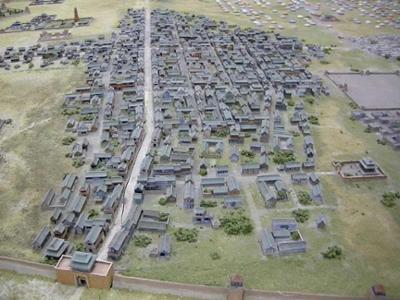


The Erdene Zuu Monastery is known as the oldest surviving Buddhist monastery in Mongolia. It is situated in Övörkhangai Province, about 2 km northeast of the center of Kharkhorin, next to the ancient city of Kharkhorin. The monastery is part of the Orkhon Valley Cultural Landscape World Heritage Site and is associated with the Gelug sect of Tibetan Buddhism.
The construction of the Erdene Zuu Monastery was commissioned by Abtai Sain Khan, the ruler of the Khalkha Mongols and the grandfather of Zanabazar, the first Jebtsundamba Khutuktu. This took place in 1585 after his meeting with the 3rd Dalai Lama and the declaration of Tibetan Buddhism as the state religion of Mongolia. Stones from the nearby ruins of the ancient Mongol capital of Kharkhorin were used in its construction. The planners aimed to create a surrounding wall resembling a Tibetan Buddhist rosary featuring 108 stupas, but this objective was likely never achieved. The monastery's temple walls were painted, and the Chinese-style roof was covered with green tiles.
The monastery was damaged in 1688 during one of the wars between the Zuungars and Khalkha Mongols. Locals dismantled the wooden fortifications of the abandoned monastery. According to tradition, in 1745, a local Buddhist disciple named Bunia made several unsuccessful attempts to fly with a device he invented, similar to a parachute.
In 1939, the communist leader Khorloogiin Choibalsan ordered the monastery to be destroyed as part of a purge that obliterated hundreds of monasteries in Mongolia and resulted in the deaths of over ten thousand monks. However, three small temples and the external wall with the stupas survived the initial onslaught. By 1944, Joseph Stalin pressured Choibalsan to maintain the monastery and Gandantegchinlen Monastery in Ulaanbaatar as a showpiece for international visitors, such as U.S. Vice President Henry Wallace, to prove that the communist regime allowed freedom of religion. In 1947, the temples were converted into museums, and for the four decades that followed, Gandantegchinlen Khiid Monastery became Mongolia's only functioning monastery.
After the fall of communism in Mongolia in 1990, the monastery was turned over to the lamas, and Erdene Zuu again became a place of worship. Today, Erdene Zuu remains an active Buddhist monastery and a museum open to tourists.
The construction of Erdene Zuu Monastery was influenced by Tibetan and Chinese architectural styles. It served as a major center for Buddhist learning and practice, housing hundreds of monks and serving as the headquarters for the Gelug sect of Tibetan Buddhism in Mongolia.
Throughout its history, Erdene Zuu Monastery faced numerous challenges. In the 17th century, it suffered severe damage during wars and invasions. However, it managed to survive and was rebuilt several times. The monastery also experienced a decline during the communist era in Mongolia when religious practices were suppressed.
Despite these challenges, Erdene Zuu Monastery has managed to preserve its cultural heritage and remains an important religious site. Today, it serves as a museum and active place of worship. Visitors can explore its impressive walls, which enclose various temples, stupas, and other religious structures. The monastery's architecture, with its vibrant colors and intricate designs, showcases the rich cultural heritage of Mongolia.
Erdene Zuu Monastery is a place of religious significance and a symbol of resilience and cultural identity for the Mongolian people. It stands as a testament to the enduring spirit of Buddhism in Mongolia and continues to attract visitors from around the world.






